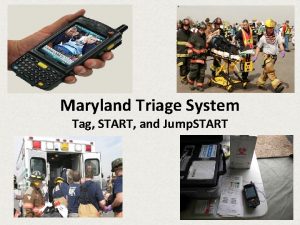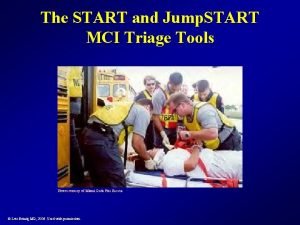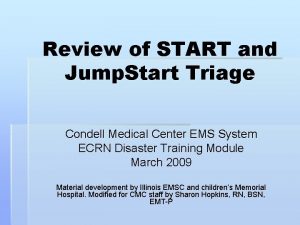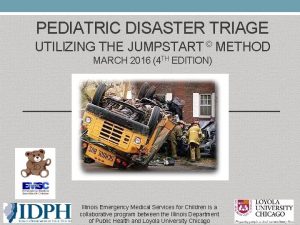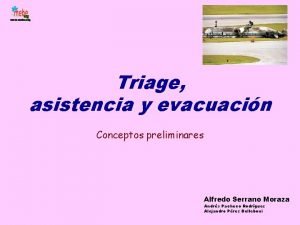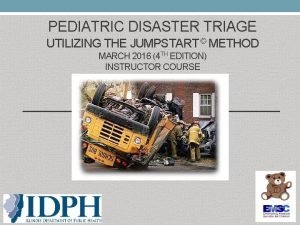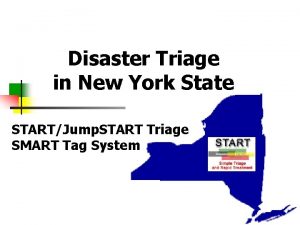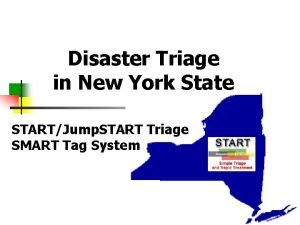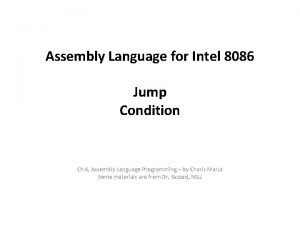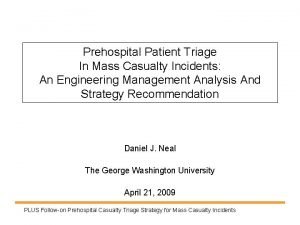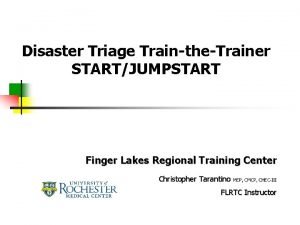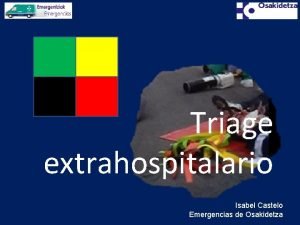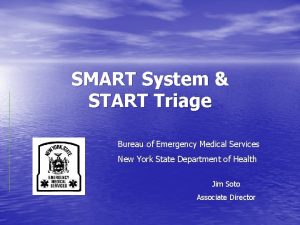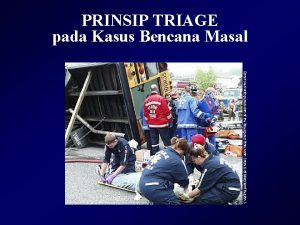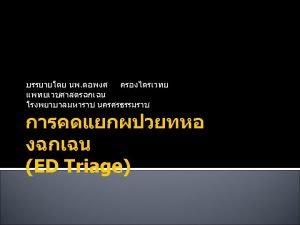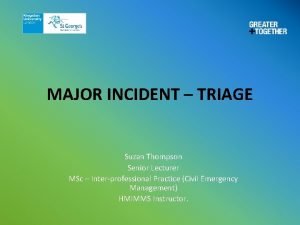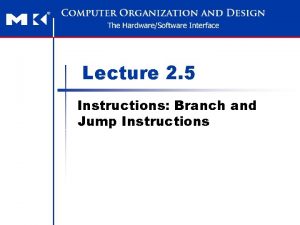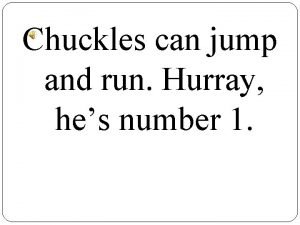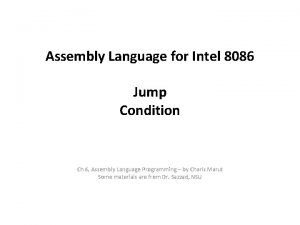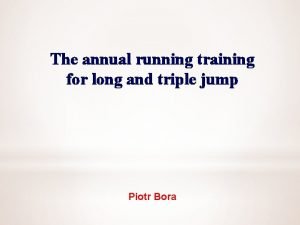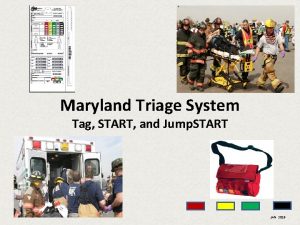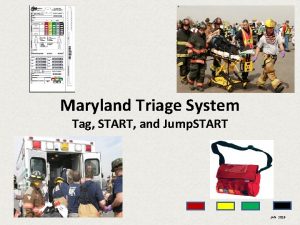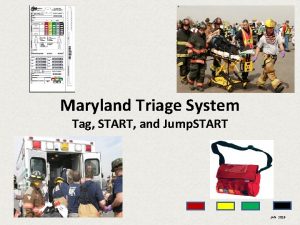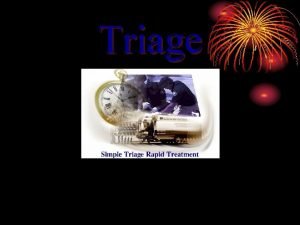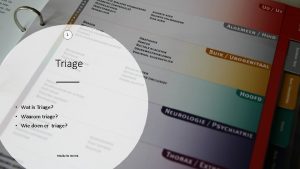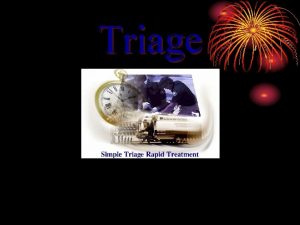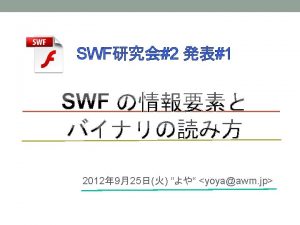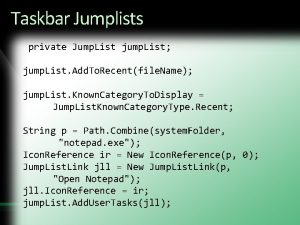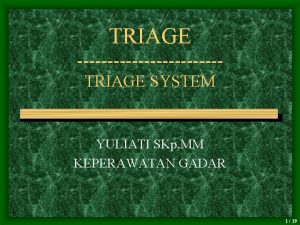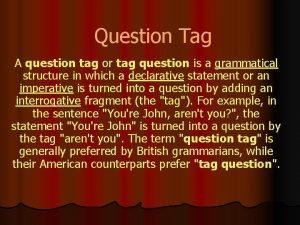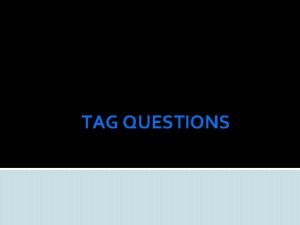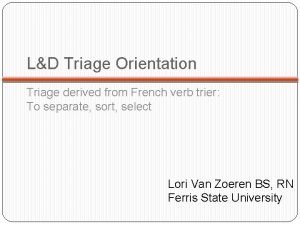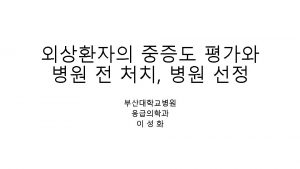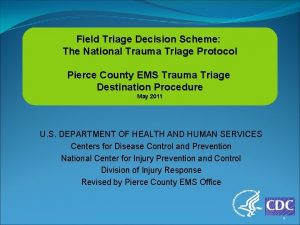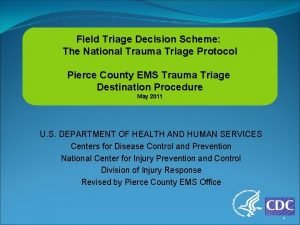Maryland Triage System Tag START and Jump START






































- Slides: 38

Maryland Triage System Tag, START, and Jump. START JAN 2019

Enabling Objectives Upon completion of this training the participant will be able to: • Define TRIAGE and explain when it is appropriate for use • List three reasons a patient triage and tracking system is required for successful operations • Categorize the Triage status of patients utilizing the START and Jump. START Triage Systems • Explain the design and use of paper Triage Tags • Identify five capabilities of the paper Maryland Triage Tags

Triage The sorting of and allocation of treatment to patients and especially battle and disaster victims according to a system of priorities designed to maximize the number of survivors (from the French trier, to sort) (Merriam-Webster) Developed by Baron Dominique-Jean Larrey, Napoleon's Chief Surgeon, for use by the first ambulance corps—the ambulances volantes—during the early 1800 s

Why Triage and Tag? • Sorting of patients to provide for the survival of the most patients • Assignment of resources in the most efficient method • Most severe survivable injuries receive rapid treatment • Accountability of patients • Family reunification

Triage: A rapid approach to prioritizing a large number of patients Incident Site Casualty Collection Point Triage Unit Leader Simple Triage And Rapid Treatment Jump. START

Triage • Triage should be performed RAPIDLY • Utilize START/ Jump. START Triage to determine priority • 15– 60 seconds per patient • Affix a color tape on upper arm or leg

START – Jump. START Triage • Clear the “walking wounded” with verbal instruction: If you can hear me and you can move, walk to… • Direct patients to the casualty collection point (CCP) or treatment area for detailed assessment and medical care • Assign a Green Minor Manager to the area to control patients and manage area • Tag will be issued at the CCP • These patients may be classified as MINOR

START/Jump. START Now use START/Jump. START to assess and categorize the remaining patients… USE COLORED RIBBONS ONLY

START/Jump. START Categorize the patients by assessing each patient’s RPMs… üRespirations üPulse/perfusion üMental Status

START/Jump. START—RPM RESPIRATIONS Is the patient breathing? Yes Adult – respirations > 30 = Red/Immediate Pediatric – respirations < 15 or > 45 = Red/Immediate Adult – respirations < 30 = check perfusion Pediatric – respirations > 15 and < 45 = check perfusion

START/Jump. START—RPM RESPIRATIONS Is the patient breathing? No Reposition the airway… Respirations begin = IMMEDIATE/RED If patient is APNEIC § Adult – deceased = BLACK § Pediatric: Pulse Present – give 5 rescue breaths § respirations begin = IMMEDIATE/RED § absent respirations – deceased = BLACK

START/Jump. START—RPM PULSE/PERFUSION Is the RADIAL pulse present? Is capillary refill (CR) LESS than < 2 seconds? Yes Check mental status No Adult: Pulse absent or CR > 2 seconds patient = IMMEDIATE/RED Pediatric: No palpable pulse patient = IMMEDIATE/RED

START/Jump. START—RPM MENTAL STATUS… Can the patient follow simple commands? Yes Adult = DELAYED / YELLOW Pediatric: alert, verbal, or pain response is appropriate = DELAYED / YELLOW No Adult = IMMEDIATE / RED Pediatric – “P” pain causes inappropriate posturing or “U” unresponsive to noxious stimuli = IMMEDIATE/ RED

START/Jump. START If the patient is IMMEDIATE/RED upon initial assessment…then, before moving the patient to the treatment area, attempt only life-saving interventions: Airway, Needle Decompression, Tourniquet, Antidote DO NOT ATTEMPT ANY OTHER TREATMENT AT THIS TIME

Combined START/Jump. START Triage CAN YOU WALK ? YES MINOR ** Using the JS algorithm evaluate all children first who did not walk under their own power. Evaluate infants first in secondary triage using entire JS algorithm ! SECONDARY TRIAGE ** NO Breathing ? NO Position Upper Airway APNEIC PEDIATRIC HAS A PULSE YES BREATHING IMMEDIATE ADULT NO PULSE APNEIC 5 Rescue Breaths Expected / Deceased BREATHING PEDI Neurological Assessment IMMEDIATE Respiratory Rate? < 30 ADULT 15 - 45 PEDI Perfusion ? YES Mental Status ? > 30 ADULT 45 > OR < 15 IMMEDIATE PEDI ADULT CR >2 Sec or NO PALPABLE PULSE PEDI - NO PALPABLE PULSE A Alert V Responds to Verbal Stimuli Responds to Painful Stimuli Unresponsive To Noxious Stimuli P U IMMEDIATE “P” INAPPROPRIATE POSTURING OR “U” ( PEDIATRIC ) DOESN’T OBEY COMMANDS IMMEDIATE ADULT OBEY COMMANDS - ADULT “A”, “V”, OR “P” ( APPROPRIATE) - PEDIATRIC Http : //www. starttriage. com Http : // www. jumpstarttriage. com DELAYED

Fast Triage – Ribbon Applied First Apply ribbon to upper arm or upper thigh

RED Triage Category (Immediate) Adult Pediatric Respirations > 30 BPM CR > 2 seconds or no palpable radial pulse Cannot follow simple commands Respirations < 15 or > 45 CR > 2 seconds or no palpable radial or brachial pulse Inappropriate “Pain” (e. g. , posturing) or “Unresponsive” Pneumothorax Hemorrhagic Shock Closed Head Injury

YELLOW Triage Category (Delayed) Adult: respirations, capillary refill, and mentation are normal • Isolated burns • Extremity fractures • Stable other trauma • Most patients with medical complaints Pediatric: “A, ” “V, ” or appropriate “P” (e. g. , withdrawal from pain stimulus)

GREEN Triage Category (Minor) • • • “Walking wounded” Psychological casualties Always look for children being carried and assess them

BLACK Triage Category (Deceased) • Obvious mortality or death (pulseless and apneic) • Decapitation • Blunt trauma arrest • Injuries incompatible with life • Brain matter visible

Revised Paper Triage Tag FRONT BACK Do Not Use Gray Category

Triage Tag Sections • • • Patient information Triage status Chief complaint Transporting unit Peel-off bar codes Transport record • • • Vital signs Medical history Treatment Family contact Wrist band * Triage tags should be used in all MCI scenarios, even when handheld device is employed

• PATIENT INFORMATION • • • Triage status Chief complaint Transporting unit Peel-off bar codes Transport record Vital signs Medical history Treatment Family contact Wrist band

The paper triage tag includes a GREY category for future use based on anticipated national acceptance. IT WILL NOT BE USED IN THE TRIAGE OF PATIENTS UNTIL APPROVED BY MIEMSS. • Patient information • TRIAGE STATUS • • • Chief complaint Transporting unit Peel-off bar codes Transport record Vital signs Medical history Treatment Family contact Wrist band

• • Patient information Triage status • CHIEF COMPLAINT • • Transporting unit Peel-off bar codes Transport record Vital signs Medical history Treatment Family contact Wrist band

• • • Patient information Triage status Chief complaint • TRANSPORTING UNIT • • Peel-off bar codes Transport record Vital signs Medical history Treatment Family contact Wrist band

• • Patient information Triage status Chief complaint Transporting unit • PEEL-OFF BAR CODES • • • Transport record Vital signs Medical history Treatment Family contact Wrist band

• Detachable as a tearoff and as a peel-off sticky label • Used to document patient movement • Must be affixed to Transport Tactical Worksheet with the unit, priority, and destination marked and initialed. Commonly called the “Ticket” • • • Patient information Triage status Chief complaint Transporting unit Peel-off bar codes • TRANSPORT RECORD • • • Vital signs Medical history Treatment Family contact Wrist band

Removable wrist band has been added with an area for DOB and name • • • Patient information Triage status Chief complaint Transporting unit Peel-off bar codes Transport record Vital signs Medical history Treatment Family contact • WRIST BAND

• • • Patient information Triage status Chief complaint Transporting unit Peel-off bar codes Transport record • VITAL SIGNS • • Medical history Treatment Family contact Wrist band

• • Patient information Triage status Chief complaint Transporting unit Peel-off bar codes Transport record Vital signs • MEDICAL HISTORY • • • Treatment Family contact Wrist band

• • Patient information Triage status Chief complaint Transporting unit Peel-off bar codes Transport record Vital signs Medical history • TREATMENT • • Family contact Wrist band

• • • Patient information Triage status Chief complaint Transporting unit Peel-off bar codes Transport record Vital signs Medical history Treatment • FAMILY CONTACT • Wrist band

Triage Summary • Triage allows for effective and efficient care, helping to increase the survivability for as many patients as possible • Assignment of resources will increase efficiency • Most severely injured patients will receive rapid treatment and transport in logical order • Ensures accountability of all patients • Allows for family reunification



Maryland Triage System MIEMSS gratefully acknowledges the following individuals for their efforts in the development of this program:

Maryland Triage System Maryland Institute for Emergency Medical Services Systems 653 West Pratt Street Baltimore, MD 21201 410 -706 -3996
 Triage start
Triage start Start disaster
Start disaster Jumpstart triage age
Jumpstart triage age Start vs jumpstart triage
Start vs jumpstart triage We're gonna jump jump jump in the river
We're gonna jump jump jump in the river Jumpstart triage
Jumpstart triage Escala rts de trauma
Escala rts de trauma Triage jump start
Triage jump start Disaster triage tag system
Disaster triage tag system Boston marathon
Boston marathon Jump assembly 8086
Jump assembly 8086 Start triage pediatric
Start triage pediatric Start triage system
Start triage system Jumpstart triage definition
Jumpstart triage definition Snap crackle pop pick up line
Snap crackle pop pick up line Ein neuer tag und ein neuer morgen
Ein neuer tag und ein neuer morgen Guten tag hallo wie gehts
Guten tag hallo wie gehts Isabel castelo
Isabel castelo Start triage
Start triage Sort triage
Sort triage Start adult triage
Start adult triage Kutf
Kutf Maryland virginia north carolina south carolina and georgia
Maryland virginia north carolina south carolina and georgia Glycolytic energy system
Glycolytic energy system If you gotta start somewhere why not here
If you gotta start somewhere why not here Ctas
Ctas Triage seive
Triage seive Maryland bar exam application
Maryland bar exam application Maryland coordination and analysis center
Maryland coordination and analysis center Jump vs branch
Jump vs branch Chuckles can jump and run
Chuckles can jump and run Long jump officials and their duties
Long jump officials and their duties Jump 8086
Jump 8086 Long and triple jump workouts
Long and triple jump workouts What are the outputs of the sign-extend and the jump
What are the outputs of the sign-extend and the jump Form of future tense
Form of future tense Earth closed system
Earth closed system Digestive system respiratory system and circulatory system
Digestive system respiratory system and circulatory system Psystart triage
Psystart triage
